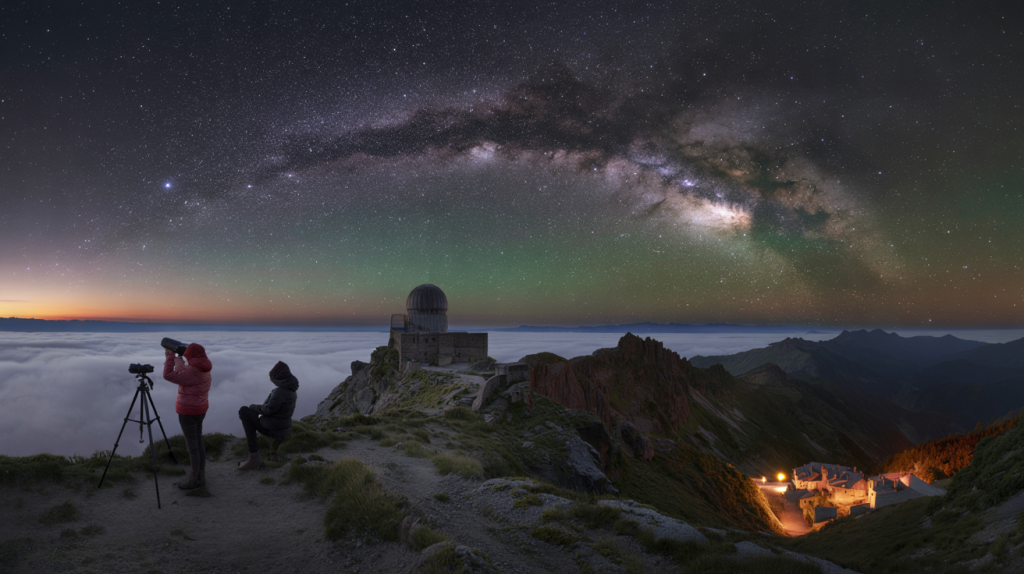Plan a night under pristine stars: France’s certified dark sky reserves reveal the Milky Way, with tips, dates and places that truly deliver.
France hides rare sanctuaries where the night still belongs to the stars. They are called dark sky reserves, certified by DarkSky International, and they let the Milky Way cut across the sky like a river of light. If the search was for a place to actually see thousands of stars with the naked eye, this is it.
Here is the context that changes the game : artificial light is rising fast worldwide. A study in Science in 2023 measured a 9.6 percent yearly increase in sky brightness perceived by observers between 2011 and 2022, which erases faint stars from view. In response, French territories such as Cévennes, Pic du Midi and Alpes Azur Mercantour earned international labels for protecting darkness, wildlife and night landscapes people forgot they could still experience.
Dark Sky Reserves in France : what they are and why they matter
Dark sky reserves are large inhabited areas that commit to low-impact lighting and sky-friendly rules, with a protected core and a cooperation zone around it. DarkSky International, founded in 1988, audits lighting plans, spectra, curfews and community engagement before granting the label.
The idea sounds technical on paper, yet it plays out simply on site : streets stay lit only where needed, lamps point down, color temperatures run warm, and curfews switch off what is not useful. People sleep better, nocturnal species move again, and visitors get black velvet skies instead of grey haze.
France also set national guardrails. The government published a regulation on outdoor lighting on 27 December 2018 that targets glare, timing and blue-rich light at night. Reserves go further, turning the policy into nightly practice, which is exactly what stargazers notice as soon as twilight fades.
Where to stargaze : Cévennes, Pic du Midi, Alpes Azur Mercantour
Cévennes National Park sits in south-central France and has earned international recognition for dark skies. Its altitude plateaus and remote valleys give panoramic horizons, so the Milky Way arches high in summer. Astronomy guides often meet at village squares then drive a few minutes to total darkness. No long hikes needed, just a warm layer.
Pic du Midi in the French Pyrenees brings a different vibe. The historic observatory crowns the summit and hosts night visits, with cable car access and telescopes above the clouds when conditions allow. On moonless nights, the galactic core rises over serrated ridgelines, and even casual eyes pick out dust lanes without effort.
Alpes Azur Mercantour spans hinterland ridges north of the Riviera. That contrast surprises first timers : busy coastal days, silent stellar nights. High valleys shelter deep darkness, yet mountain roads keep access realistic for families and travellors who just want a two-hour window under the stars before bedtime.
When to go and how to prepare : practical tips that work
Pick a date near new moon if the goal is Milky Way detail. Late June to early September shows it best in the evening, while winter offers crystal clarity and Orion blazing overhead. Avoid humid nights after heatwaves, and check wind forecasts in the mountains for steady air.
Arrive before dusk, let your eyes adapt for 20 minutes, then keep lights red and dim. Photos are great, but white phone beams will wipe out nearby night vision. Local guides often organize small-group outings linked to village events or the national “Nuit des étoiles” created in 1991 by the Association Française d’Astronomie.
What to bring pays off fast :
- A warm layer and hat, even in August at altitude
- Red-light headlamp or a phone set to red, brightness at minimum
- Binoculars 7×50 or 10×50 for star fields and nebulae
- Printed sky map or an app in night mode
- Tripod for phones or cameras, exposure 10 to 20 seconds
Light pollution in numbers : the stakes behind the magic
The landmark New World Atlas of Artificial Night Sky Brightness reported in 2016 that about 60 percent of Europeans cannot see the Milky Way from where they live, and that 99 percent of the population in Europe experiences some level of light-polluted sky. Those figures explain why first-time visitors often gasp when the reserve sky turns fully dark.
The same Science paper in 2023 highlighted how quickly we can lose faint stars to skyglow, year after year. That trend is not abstract. In towns just outside reserves, the difference is visible across a short drive. Inside, curfews and warmer spectra shift the night back toward natural contrast, which is exactly what makes deep-sky objects pop in binoculars.
One more link closes the loop : protecting darkness protects life. Researchers have documented disrupted pollination at night and altered migration for birds when lighting spills into habitat. Reserve policies cut unnecessary light at its source, so people enjoy safer, smarter illumination while nature keeps its rhythm. The result is an experience that feels rare and, very simply, beautiful to share.
